One-Step Chromatographic Approach for Purifying Peptides and Proteins from Venoms
Abstract
1. Introduction
2. Materials and Methods
2.1. RP-HPLC Purification
2.2. Mass Spectrometry Analysis
3. Results and Discussion
3.1. Purification of α-Bungarotoxin (α-Bgtx)
3.2. Purification of α-Cobratoxin (α-Cbtx)
3.3. Purification of Calciseptine
3.4. Purification of Melittin
3.5. Purification of Notexin
3.6. Purification of CVFm
4. Conclusions
Author Contributions
Funding
Data Availability Statement
Conflicts of Interest
References
- Morsy, M.A.; Gupta, S.; Dora, C.P.; Jhawat, V.; Dhanawat, M.; Mehta, D.; Gupta, K.; Nair, A.B.; El-Daly, M. Venoms classification and therapeutic uses: A narrative review. Eur. Rev. Med. Pharmacol. Sci. 2023, 27, 1633–1653. [Google Scholar] [CrossRef]
- Mabrouk, K.; Ram, N.; Boisseau, S.; Strappazzon, F.; Rehaim, A.; Sadoul, R.; Darbon, H.; Ronjat, M.; De Waard, M. Critical amino acid residues of maurocalcine involved in pharmacology, lipid interaction and cell penetration. Biochim. Biophys. Acta Biomembr. 2007, 1768, 2528–2540. [Google Scholar] [CrossRef] [PubMed]
- González García, M.C.; Radix, C.; Villard, C.; Breuzard, G.; Mansuelle, P.; Barbier, P.; Tsvetkov, P.O.; De Pomyers, H.; Gigmes, D.; Devred, F.; et al. Myotoxin-3 from the Pacific Rattlesnake Crotalus oreganus oreganus Venom Is a New Microtubule-Targeting Agent. Molecules 2022, 27, 8241. [Google Scholar] [CrossRef] [PubMed]
- Chalier, F.; Mugnier, L.; Tarbe, M.; Aboudou, S.; Villard, C.; Kovacic, H.; Gigmes, D.; Mansuelle, P.; de Pomyers, H.; Luis, J.; et al. Isolation of an anti–tumour disintegrin: Dabmaurin–1, a Peptide Lebein–1–Like, from Daboia mauritanica Venom. Toxins 2020, 12, 102. [Google Scholar] [CrossRef] [PubMed]
- Gosselin, R.C.; Douxfils, J. Ecarin based coagulation testing. Am. J. Hematol. 2020, 95, 863–869. [Google Scholar] [CrossRef] [PubMed]
- Verdoni, M.; Roudaut, H.; De Pomyers, H.; Gigmes, D.; Bertin, D.; Luis, J.; Mabrouk, K. ArgTX-636, a polyamine isolated from spider venom: A novel class of melanogenesis inhibitors. Bioorg. Med. Chem. 2016, 24, 5685–5692. [Google Scholar] [CrossRef] [PubMed]
- Smallwood, T.B.; Clark, R.J. Advances in venom peptide drug discovery: Where are we at and where are we heading? Expert Opin. Drug Discov. 2021, 16, 1163–1173. [Google Scholar] [CrossRef]
- King, G.F. Venoms as a platform for human drugs: Translating toxins into therapeutics. Expert Opin. Biol. Ther. 2011, 11, 1469–1484. [Google Scholar] [CrossRef]
- Thermo Fisher Scientific Inc. Successful Separations of Peptides, Proteins and Other Biomolecules HPLC Analysis of Biomolecules Technical Guide. Available online: www.thermoscientific.com/chromatography (accessed on 25 May 2010).
- Jean, R.; McClintock, R. Reversed-phase high-performance liquid chromatography of insulins from different species. J. Chromatogr. A 1983, 268, 112–119. [Google Scholar]
- Carr, D. The Handbook of Analysis and Purification of Peptides and Proteins by Reversed Phase HPLC; Grace Vydac: Hesperia, CA, USA, 2002; pp. 1–14. [Google Scholar]
- Brun, O.; Zoukimian, C.; Oliveira-Mendes, B.; Montnach, J.; Lauzier, B.; Ronjat, M.; Béroud, R.; Lesage, F.; Boturyn, D.; De Waard, M. Chemical Synthesis of a Functional Fluorescent-Tagged α-Bungarotoxin. Toxins 2022, 14, 79. [Google Scholar] [CrossRef]
- Wongtongkam, N.; Wilde, H.; Sitthi-Amorn, C.; Ratanabanangkoon, K. A Study of Thai Cobra (Naja kaouthia) Bites in Thailand. 2005. Available online: https://academic.oup.com/milmed/article/170/4/336/4577729 (accessed on 1 April 2005).
- de Weille, J.R.; Schweitz, H.; Maes, P.; Tartar, A.; Lazdunski, M. Calciseptine, a peptide isolated from black mamba venom, is a specific blocker of the L-type calcium channel. Proc. Natl. Acad. Sci. USA 1991, 88, 2437–2440. [Google Scholar] [CrossRef] [PubMed]
- Han, S.; Yeo, J.; Baek, H.; Lin, S.M.; Meyer, S.; Molan, P. Postantibiotic effect of purified melittin from honeybee (Apis mellifera) venom against Escherichia coli and Staphylococcus aureus. J. Asian Nat. Prod. Res. 2009, 11, 796–804. [Google Scholar] [CrossRef] [PubMed]
- Guha, S.; Ferrie, R.P.; Ghimire, J.; Ventura, C.R.; Wu, E.; Sun, L.; Kim, S.Y.; Wiedman, G.R.; Hristova, K.; Wimley, W.C. Applications and evolution of melittin, the quintessential membrane active peptide. Biochem. Pharmacol. 2021, 193, 114769. [Google Scholar] [CrossRef] [PubMed]
- Dixon, R.W.; Harris, J.B. Myotoxic activity of the toxic phospholipase, notexin, from the venom of the Australian tiger snake. J. Neuropathol. Exp. Neurol. 1996, 55, 1230–1237. [Google Scholar] [CrossRef] [PubMed]
- Karisson, E.; Eaker, D.; Rydén, L. Purification of a presynaptic neurotoxin from the venom of the Australian tiger snake Notechis scutatus scutatus. Toxicon 1972, 10, 405–413. [Google Scholar] [CrossRef] [PubMed]
- Osipov, A.V.; Mordvintsev, D.Y.; Starkov, V.G.; Galebskaya, L.V.; Ryumina, E.V.; Bel’tyukov, P.P.; Kozlov, L.V.; Romanov, S.V.; Doljansky, Y.; Tsetlin, V.I.; et al. Naja melanoleuca cobra venom contains two forms of complement-depleting factor (CVF). Toxicon 2005, 46, 394–403. [Google Scholar] [CrossRef] [PubMed]
- Laemmli, U.K. Cleavage of Structural Proteins during the Assembly of the Head of Bacteriophage T4. Nature 1970, 227, 680–685. [Google Scholar] [CrossRef] [PubMed]
- Krayem, N.; Parsiegla, G.; Gaussier, H.; Louati, H.; Jallouli, R.; Mansuelle, P.; Carrière, F.; Gargouri, Y. Functional characterization and FTIR-based 3D modeling of full length and truncated forms of Scorpio maurus venom phospholipase A2. Biochim. Biophys. Acta Gen. Subj. 2018, 1862, 1247–1261. [Google Scholar] [CrossRef] [PubMed]
- Kpebe, A.; Guendon, C.; Payne, N.; Ros, J.; Khelil Berbar, M.; Lebrun, R.; Baffert, C.; Shintu, L.; Brugna, M. An essential role of the reversible electron-bifurcating hydrogenase Hnd for ethanol oxidation in Solidesulfovibrio fructosivorans. Front. Microbiol. 2023, 14, 1139276. [Google Scholar] [CrossRef]
- Hanley, M.R.; Eterovic, V.A.; Hawkes, S.P.; Hebert, A.J.; Bennett, E.L. Neurotoxins of Bungarus multicinctus venom purification and partial characterization. Biochemistry 1977, 16, 5840–5849. [Google Scholar] [CrossRef]
- Eterovic, V.A.; Hebert, M.S.; Hanley, M.R.; Bennett, E.L. The lethality and spectroscopic properties of toxins from Bungarus multicinctus (Blyth) venom*. Toxicon 1975, 13, 37–48. [Google Scholar] [CrossRef] [PubMed]
- Eterović, V.A.; Aune, R.G.; Bennett, E.L. Radioactive Labeling of cx-Bungarotoxin with Tritium. Anal. Biochem. 1975, 68, 394–403. [Google Scholar] [CrossRef] [PubMed]
- Mebs, D.; Nan, K.; Iwanaga, S.; Samejima, Y.; Nan Lee, C. Purification, Properties and Amino Acid Sequence of a-Bungarotoxin from the Venom of Bungarus multicinctus. Biol. Chem. 1972, 353, 243–262. [Google Scholar]
- Kukhtina, V.V.; Weise, C.; Muranova, T.A.; Starkov, V.G.; Franke, P.; Hucho, F.; Wnendt, S.; Gillen, C.; Tsetlin, V.I.; Utkin, Y.N. Muscarinic toxin-like proteins from cobra venom. Eur. J. Biochem. 2000, 267, 6784–6789. [Google Scholar] [PubMed]
- Schweitz, H.; Bidard, J.-N.; Lazdunski, M. Purification and pharmacological characterization of peptide toxins from the black mamba (Dendroaspis polylepis) venom. Toxicon 1990, 28, 847–856. [Google Scholar] [CrossRef] [PubMed]
- Teoh, A.C.L.; Ryu, K.H.; Lee, E.G. One-step purification of melittin derived from Apis mellifera bee venom. J. Microbiol. Biotechnol. 2017, 27, 84–91. [Google Scholar] [CrossRef]
- Chwetzoff, S.; Mollier, P.; Bouet, F.; Rowan, E.C.; Harvey, A.L. On the purification of notexin Isolation of a single amino acid variant from the venom of Nutechis scutatus scutatus. FEBS Lett. 1990, 261, 226–230. [Google Scholar] [CrossRef] [PubMed]
- Halpert, J.; Eaker, D.; Karlsson, E. The role of phospholipase activity in the action of a presynaptic neurotoxin from the venom of Notechis scutatus scutatus (Australian tiger Snake). FEBS Lett. 1976, 61, 72–76. [Google Scholar] [CrossRef]
- Yang, C.-C.; Chang, L.-S. The N-terminal amino group essential for the biological activity of notexin from Notechis scutatus scutatus venom. Biochim. Biophys. Acta 1990, 1040, 35–42. [Google Scholar] [CrossRef]


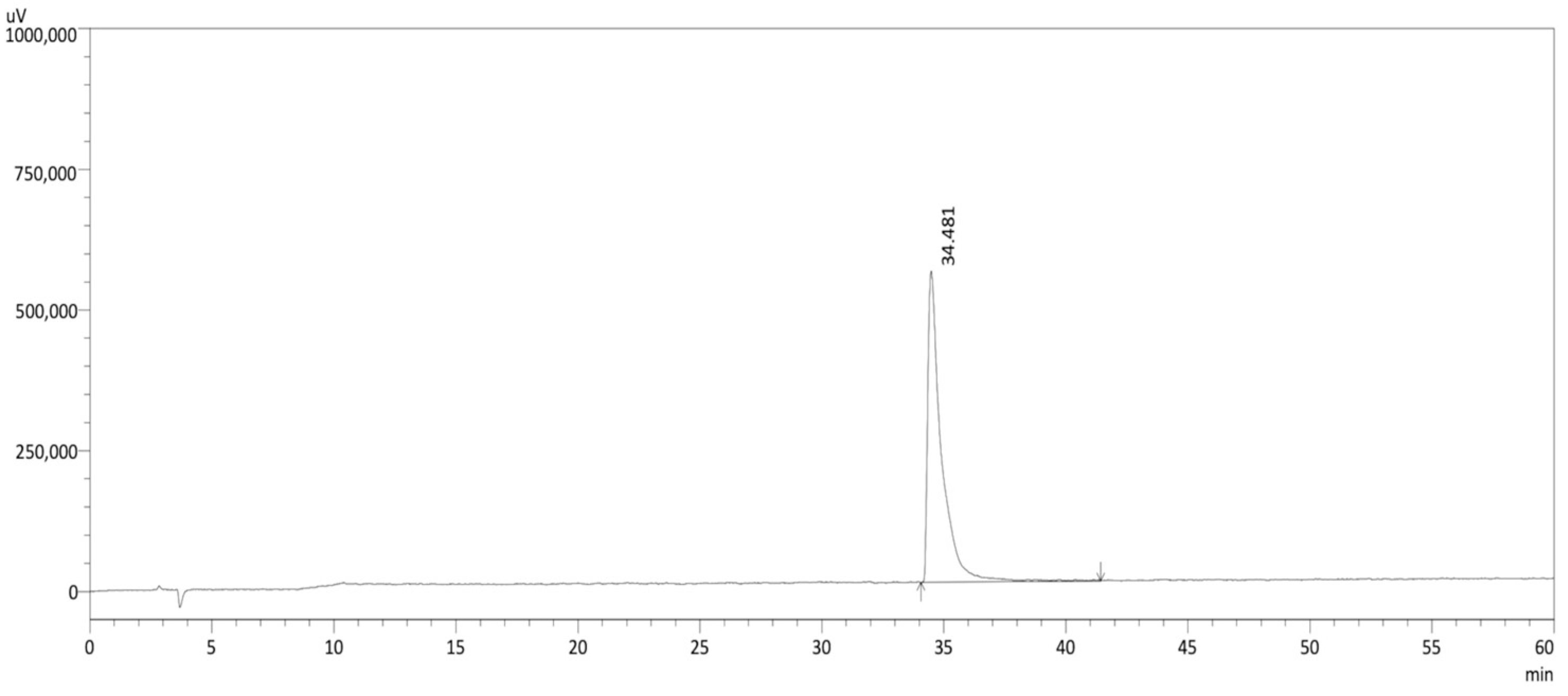

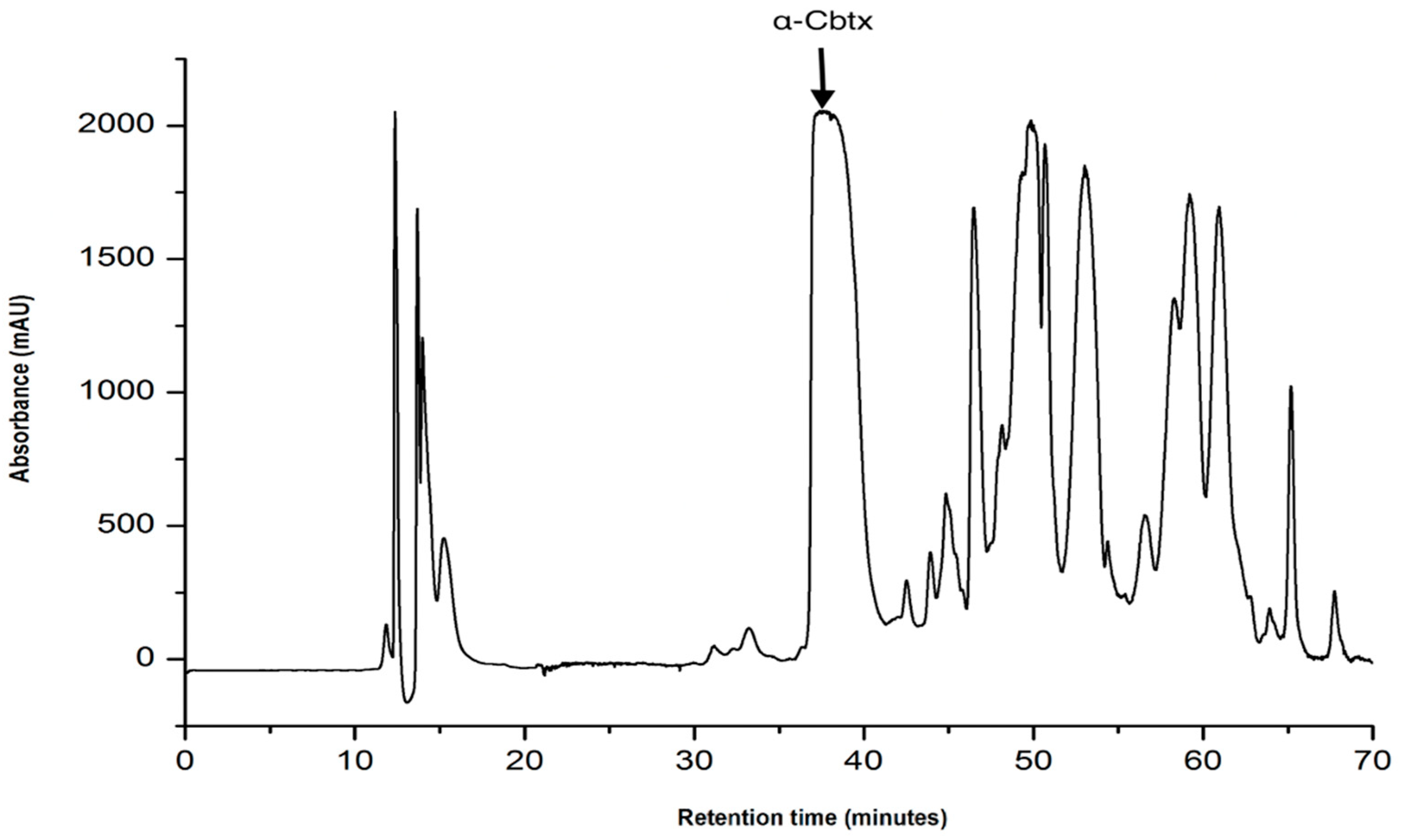
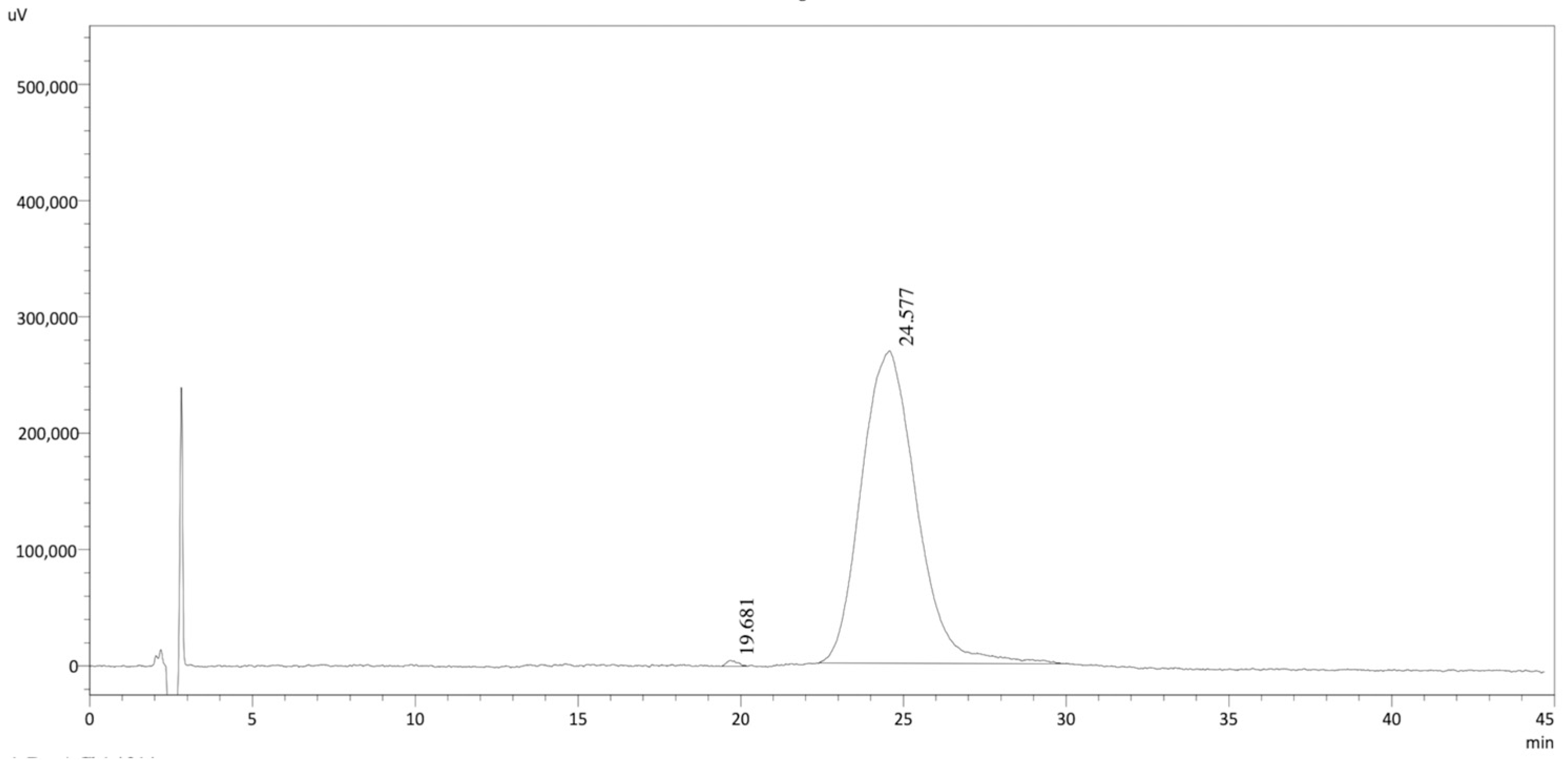

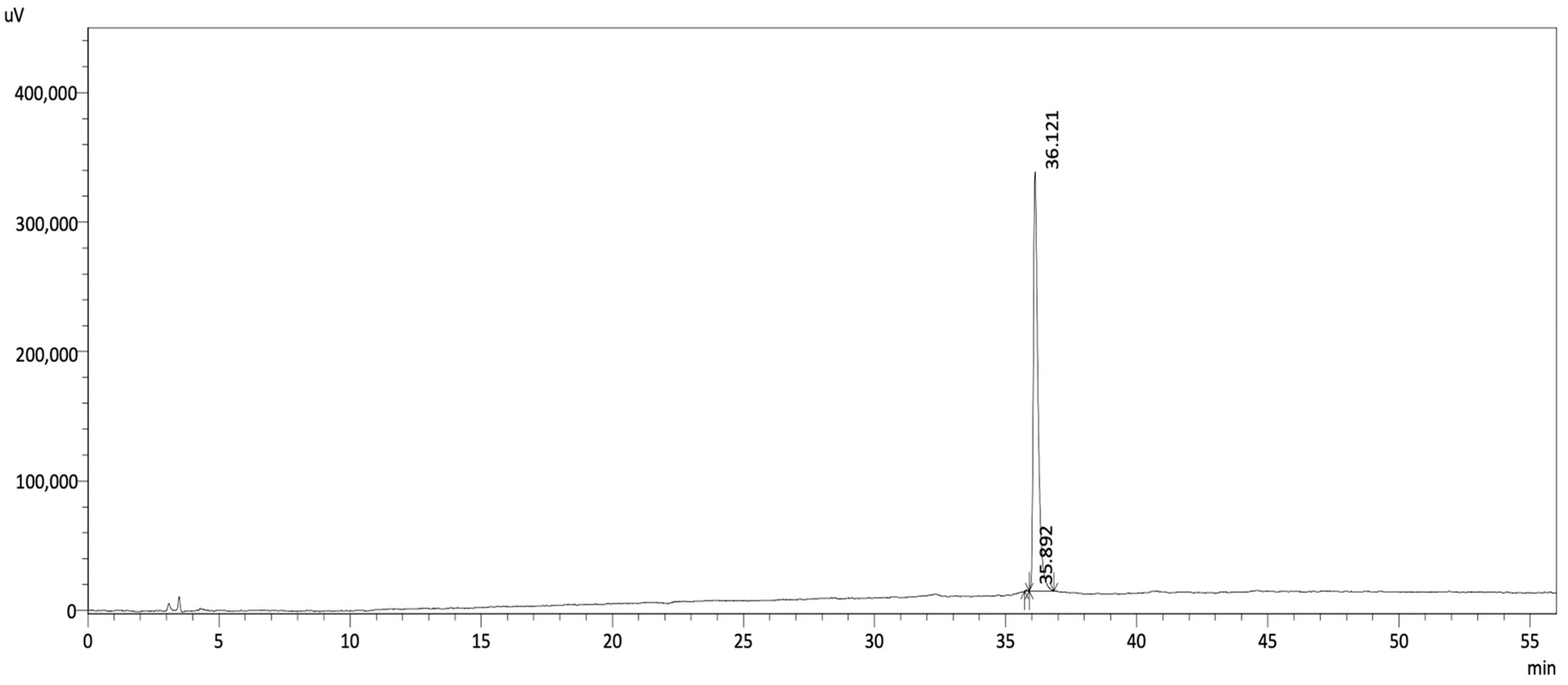
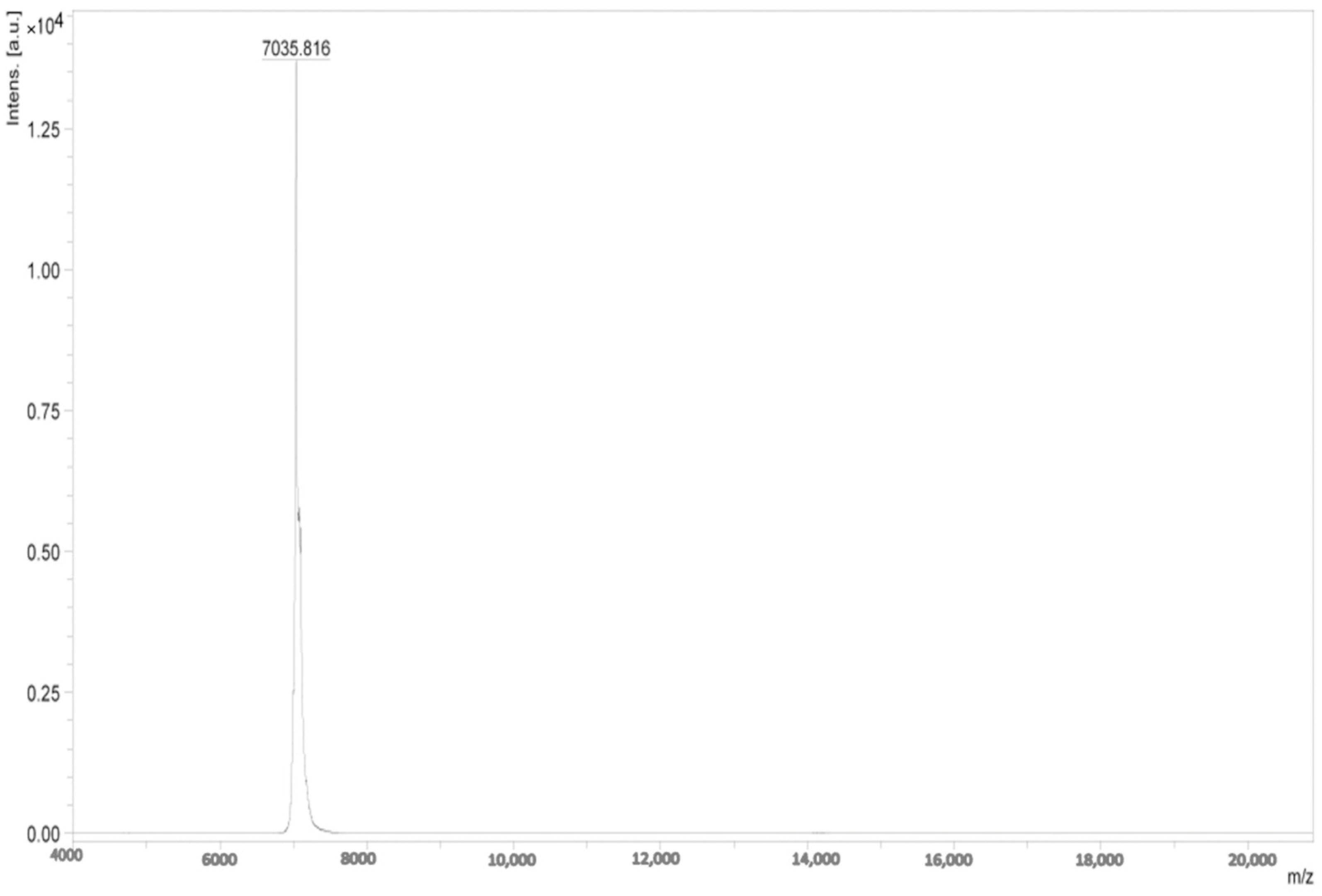



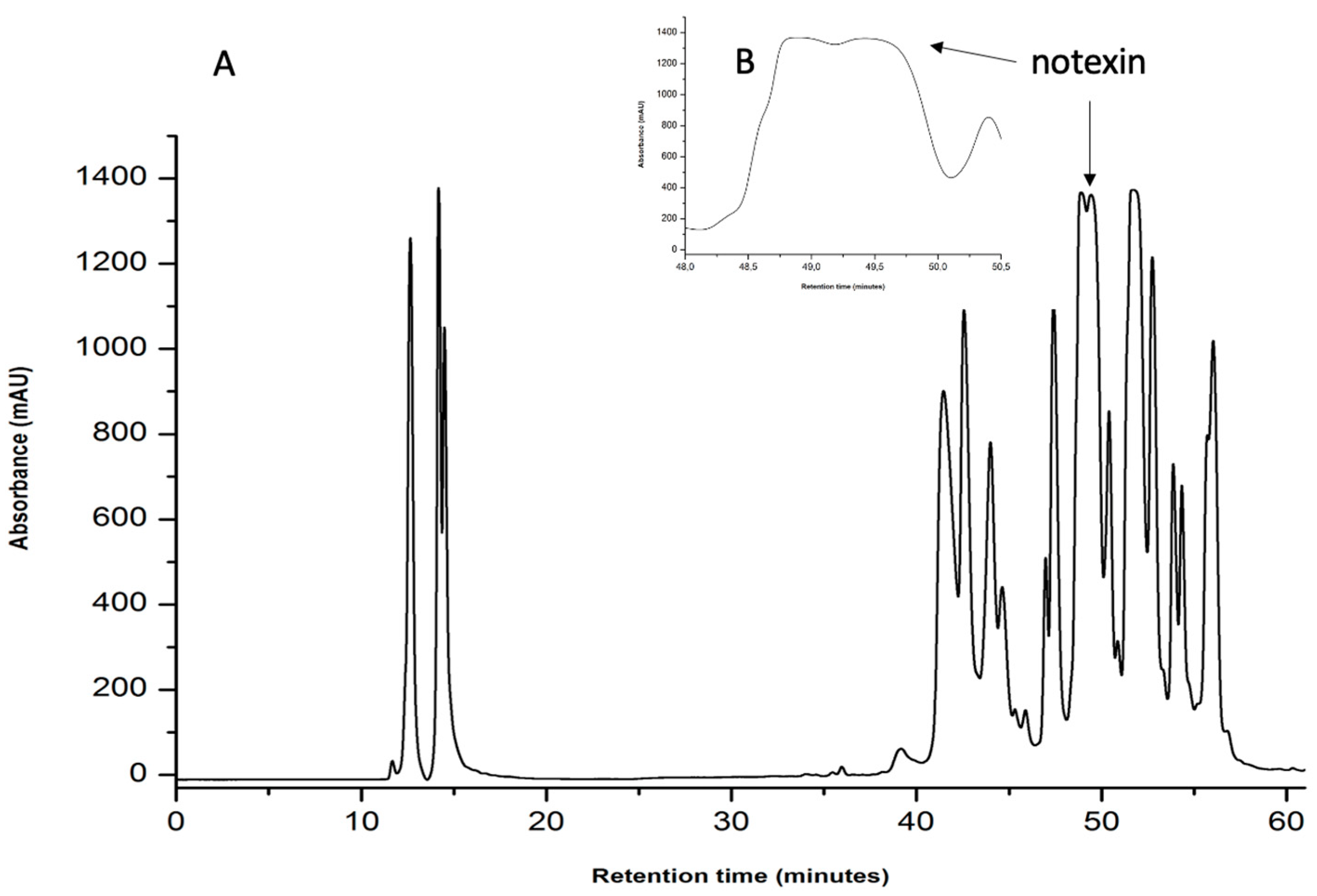
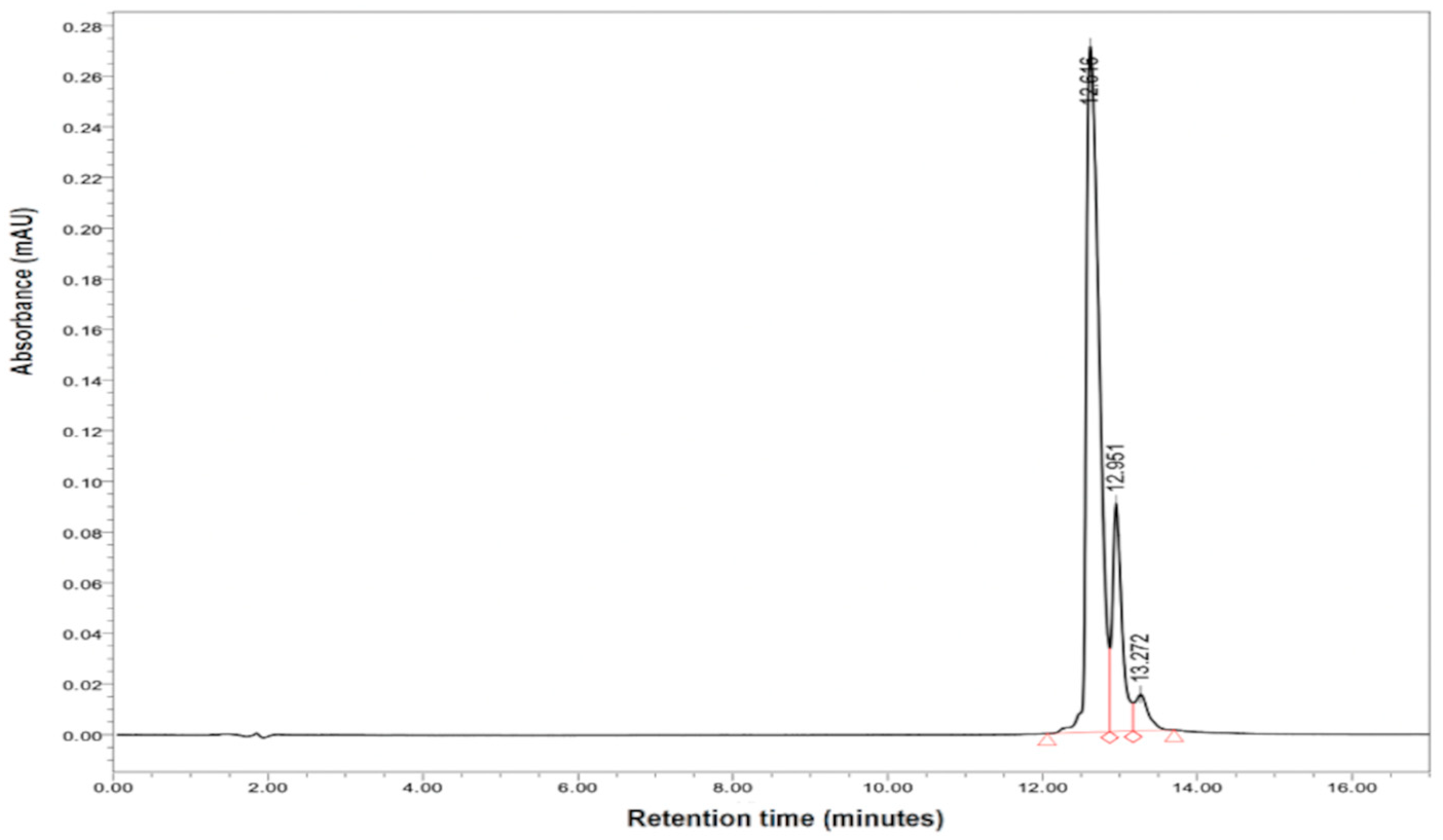

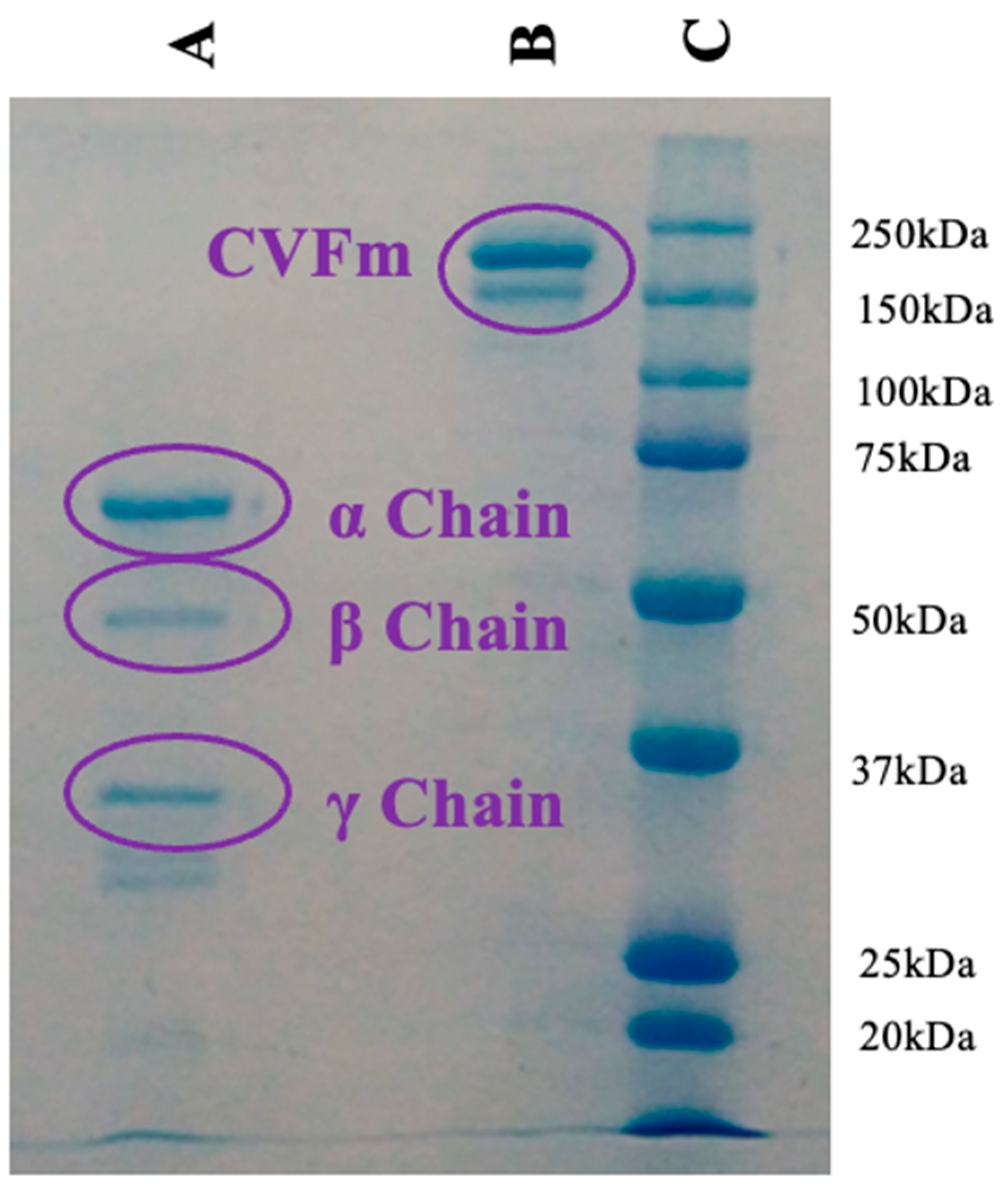
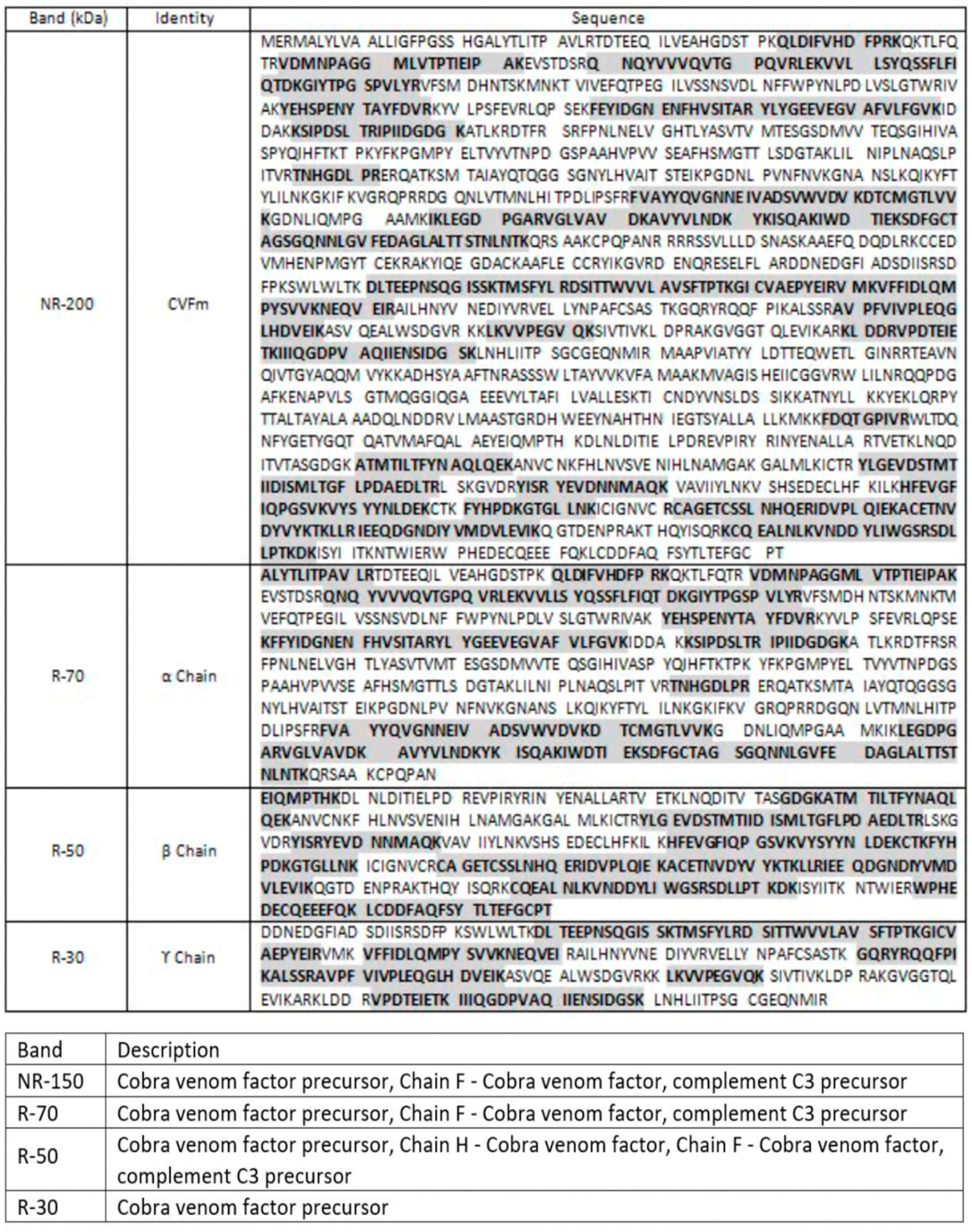

| Protein-MW (kDa) | Venom | Preparative Conditions Agilent 1260 Infinity (Agilent Technologies, Santa Clara, CA, USA) | Analytical Conditions Shimadzu LC-2010 HPLC (Shimadzu, Kyoto, Japan) | Retention Time (min) | Homogeneity/ Yield |
|---|---|---|---|---|---|
| α-bungarotoxin 7.983 | Bungarus multicinctus |
|
| 35 | 99%—7% |
| α-Cobratoxin-7.821 | Naja kaouthia |
|
| 24.5 | 99%—15% |
| Calciseptine-7.035 | Dendroaspis polylepis polylepis |
|
| 36 | 95%—6% |
| Melittin-2.846 | Apis mellifera |
|
| 21.7 | 99%—4.5% |
| Notexin-13.593 (Np and Ns) | Notechis scutatus |
|
| 12.6 | 95%—10% |
| CVFm-150 | Naja melanoleuca |
|
| 23 | 94%—0.8% |
Disclaimer/Publisher’s Note: The statements, opinions and data contained in all publications are solely those of the individual author(s) and contributor(s) and not of MDPI and/or the editor(s). MDPI and/or the editor(s) disclaim responsibility for any injury to people or property resulting from any ideas, methods, instructions or products referred to in the content. |
© 2024 by the authors. Licensee MDPI, Basel, Switzerland. This article is an open access article distributed under the terms and conditions of the Creative Commons Attribution (CC BY) license (https://creativecommons.org/licenses/by/4.0/).
Share and Cite
Boughanmi, Y.; Aboudou, S.; Boyadjian, K.; Charouandi, A.; Bouzid, S.; Barnetche, T.; Mansuelle, P.; Lebrun, R.; Gigmes, D.; de Pomyers, H.; et al. One-Step Chromatographic Approach for Purifying Peptides and Proteins from Venoms. Separations 2024, 11, 179. https://doi.org/10.3390/separations11060179
Boughanmi Y, Aboudou S, Boyadjian K, Charouandi A, Bouzid S, Barnetche T, Mansuelle P, Lebrun R, Gigmes D, de Pomyers H, et al. One-Step Chromatographic Approach for Purifying Peptides and Proteins from Venoms. Separations. 2024; 11(6):179. https://doi.org/10.3390/separations11060179
Chicago/Turabian StyleBoughanmi, Yasmine, Soioulata Aboudou, Kayané Boyadjian, Acil Charouandi, Sarra Bouzid, Thelma Barnetche, Pascal Mansuelle, Régine Lebrun, Didier Gigmes, Harold de Pomyers, and et al. 2024. "One-Step Chromatographic Approach for Purifying Peptides and Proteins from Venoms" Separations 11, no. 6: 179. https://doi.org/10.3390/separations11060179
APA StyleBoughanmi, Y., Aboudou, S., Boyadjian, K., Charouandi, A., Bouzid, S., Barnetche, T., Mansuelle, P., Lebrun, R., Gigmes, D., de Pomyers, H., & Mabrouk, K. (2024). One-Step Chromatographic Approach for Purifying Peptides and Proteins from Venoms. Separations, 11(6), 179. https://doi.org/10.3390/separations11060179







